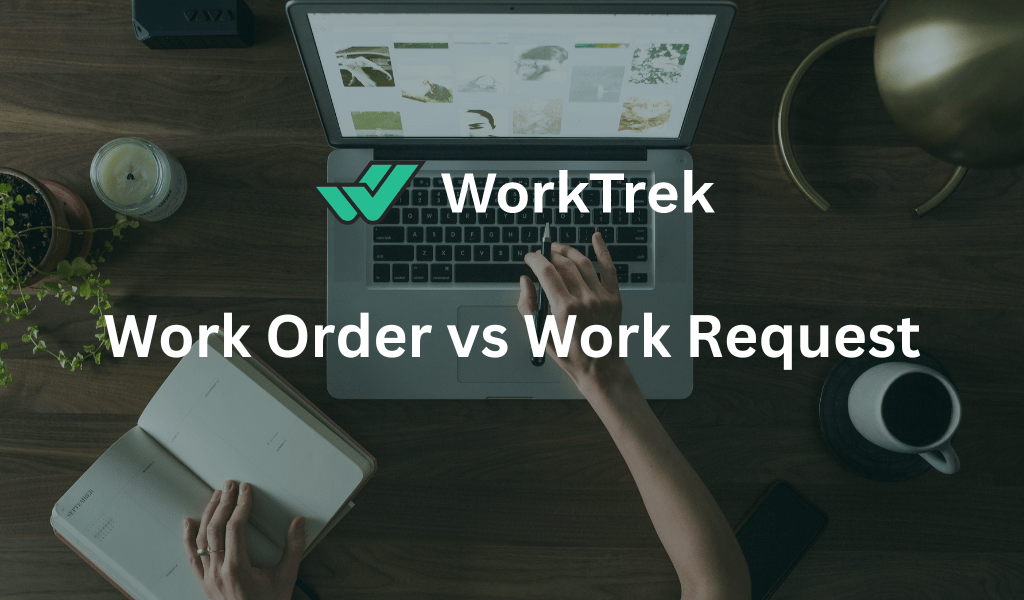Get a Free WorkTrek Demo
Let's show you how WorkTrek can help you optimize your maintenance operation.
Try for freeIt is common for novice maintenance workers to confuse work requests with work orders. However, there is a distinct difference between the two terms. A work request represents a call to perform maintenance work on a specific asset. Technically, management can approve or deny this request.
Alternatively, a work order is an authorization assigned to planned maintenance work to be completed. Once submitted and approved, a work request becomes a work order. They are approved by the maintenance manager or maintenance planner.
What is a Work Order
A work order is a paper or digital document which provides all the information regarding a maintenance operation. In fact, it represents the first step to be taken following the receipt of a request for intervention or based on a pre-established preventive maintenance schedule.
Since a work order management does not complete its life cycle after the activation of the intervention it prescribes, it is good practice to regulate its management within company processes through a specific procedure. For this reason, the work order is included in the maintenance process descriptions that give rise to organizational procedures. Learn more about work order and how to use it.

What does Work Order management include?
A well-structured work order management should include at least the following details:
- Name and surname or department of the person requesting the intervention
- Name and surname of the person who authorized the work
- Which asset, machinery, or plant it refers to, and its location
- Purpose of the intervention
- Description of the problem
- Type of surgery
- Priority level
- Name and surname of the technician to whom you have been assigned (it can be an internal or external resource)
- Prerequisites for completing the objective (e.g. expected spare parts, required tools, documents, notes, checklists)
- Estimated date of start and end of work
Given these premises, it is clear that the correct compilation of a work order, its management before, during, and after the intervention, as well as its archiving and the ability to analyze it, play a fundamental role in making maintenance processes more efficient within a company.
The use of CMMS maintenance software such as WorkTrek makes it easier and in many respects automatic to manage the work order throughout its life cycle. It also allows you to plan the intervention efficiently, coordinating all the parties involved and adding all the necessary documentation with a click. But the greatest benefit is undoubtedly the traceability of all operations which unequivocally contributes to making maintenance processes more orderly, precise, and efficient.
Types of Work Orders
There are at least two types of work orders that differ based on the very reason they are created.
Work order generated by an intervention request: the first case is a response to a breakdown or anomaly. We, therefore, speak of corrective maintenance intervention. The work order management is generated following the receipt of an intervention request from a person who is usually external to the maintenance team.
Work order generated by a scheduled maintenance action: The second type is generated by a preventive action and is therefore prior to the occurrence of a failure. In this case, therefore, we will not have any request for intervention, but only a maintenance action planned during the creation of a maintenance plan, such as a time deadline for example. See also, work order guidelines.

Work Order Workflow
As we said, the life cycle of a work order does not end with its creation. In fact, we can identify at least 5 fundamental steps that coincide with as many phases of each operation.
Work order creation
It is the phase following the receipt of a request for intervention or the drafting of a maintenance plan. In this second case, relating to a preventive or scheduled maintenance operation, the work order will be created in advance or automatically (if we have CMMS maintenance software).
Work order assignment and scheduling
It is the phase in which we assign the task to a resource (which can be internal or external, in case we rely on a service provider). Once assigned we can add it to the calendar, taking into account the availability of the technician and our needs. In the event of a corrective maintenance intervention, it may be necessary to reschedule some work orders already scheduled to make room for what we are adding. In this case, if you have a CMMS, the calendar and all work orders involved will be moved and updated automatically.
Carrying out the intervention
In this phase of the life cycle of a work order, the assigned technician or supplier receives a notification and can consult the work order to access all the information contained therein, from the location of the asset to the checklists that we have added to the work order.
Closing the work order
Once the intervention has been completed, the assigned technician or supplier adds the costs of the operation to the work order, fills in and signs the report and, if necessary, updates it with new notes. If we use CMMS maintenance software, these operations will be carried out digitally simply from your mobile phone, including sending the signed report.
Work order archiving
The last step involves the archiving phase of the work order. All the information contained in the work order is entered into the maintenance management system. A CMMS software is able to process this information automatically, adding it to the asset history without requiring any additional intervention on the part of the manager. Learn more about workflow for work orders.

What Is a Work Request?
A work request is a document that notifies a facility manager when maintenance is required for a particular facility. Customers and maintainers will sometimes submit them after finding out that something doesn’t work properly. Reports can be submitted manually on paper or through digital platforms such as computerized maintenance management systems (CMMS).
Maintenance personnel ensures that facilities, equipment, and grounds are kept in good working order management at all times. By responding to work requests, these individuals play an important role in keeping the organization’s stakeholders productive, comfortable, and safe.
If requests are not managed well, they can become a burdensome backlog that hinders an organization’s productivity. Once the maintenance department is significantly behind schedule, getting the mean time to repair (MTTR) back to normal levels can be challenging. Therefore, maintenance teams must prioritize work orders through an overall maintenance strategy and workflow before scheduling work orders. Consider reading also, what is CMMS.

Types Of Work Requests
Depending on the type of industry, company size, and size of the maintenance team, job requirements can be categorized in different ways. Below are a few different types of maintenance requests.
By requester type
- Tenant Requests: A/C malfunctioning, toilets running, drywall repairs
- Operator Demands: machine stoppages, high scrap rates, fluid leaks
- Employee Requests: moving furniture, changing office lighting, carpet repair
By institution category
- School requirements: toilets, classrooms, laboratory maintenance
- Parking Requests: lawn, landscaping, sign restoration
- Industrial supplies: maintenance of blast furnaces, boilers, food conveyor belts
Categorize by priority
- Discretion (important but not mandatory): paint office, move furniture, upgrade cubicles
- Non-Discretionary (Mandatory)
- Emergencies (related to protecting life or preventing loss of expensive assets): chemical spills, power outages, sidewalk deicing
- Urgent (related to timeliness of required work): toilet hot water restoration, air conditioning repair, urinal operation
- Routine: preventative maintenance, routine cleaning, mowing
- Irregular: in addition to urgent and urgent work, this includes planned special projects
Learn more about how to implement a work order management process.
Elements Of An Effective Job Request
The more detailed the documentation, the higher the likelihood that the operations manager will approve the maintenance request. Effective job requirements contain the following main elements: Inquiry – Maintenance technicians, customers, tenants, and department members within the organization can submit them.

Problem – Through digital or analog documents, the requester identifies the main issues requiring service. Examples of typical facility issues include vehicle maintenance, landscaping, snow removal, carpentry, and leaking faucets.
Location – If the organization has multiple facilities, the request should identify the specific facility or area that requires maintenance.
Priority – Prioritization is based on the extent to which the reported issue impacts the bottom line, stakeholder well-being, or the overall security of the organization. While tenants cannot assign priorities, internal organizers should assign high, medium, or low priority to each document.
Estimated budget – Maintenance technicians sometimes include cost estimates in requirements documents. This simplifies the planning of maintenance work and the procurement of spare parts. Estimates also help manage approvals, accounting, and financial records.
See also our blog on maintainability, definition & explanation.
Try now for free
If you want the success of any maintenance action, you should try a WorkTrek!
Difference Between a Work Order And a Work Request
The two terms are similar and can often be confused with each other.
Work request: A work request is usually generated by personnel who are not part of the maintenance staff. This is not a work order, but rather a pre-creation stage. It consists in signaling a fault or anomaly (this is called corrective maintenance). An intervention request can be generated through traditional means (such as a telephone call, a message, or an email) or through the appropriate intervention request form via CMMS.
Work Order: Represents the step following the issue of a request for intervention, through which the request is taken on board by organizing the intervention. It is managed by the supervisor, a maintenance manager, or a member of staff.
Correct management of work orders and work requests using CMMS maintenance software guarantees a substantial reduction in intervention times and total traceability of all operations. It also simplifies the reporting of costs and working times.
Being able to manage the work order at every stage of its life cycle, including archiving, ensures access to a company information asset of the highest value: being able to work on this data, through statistical analysis and customized reports, allows us to make informed and data-driven decisions to improve processes and guarantee the highest levels of efficiency and production.









